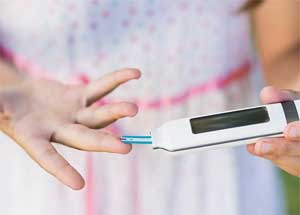- Home
- Editorial
- News
- Practice Guidelines
- Anesthesiology Guidelines
- Cancer Guidelines
- Cardiac Sciences Guidelines
- Critical Care Guidelines
- Dentistry Guidelines
- Dermatology Guidelines
- Diabetes and Endo Guidelines
- Diagnostics Guidelines
- ENT Guidelines
- Featured Practice Guidelines
- Gastroenterology Guidelines
- Geriatrics Guidelines
- Medicine Guidelines
- Nephrology Guidelines
- Neurosciences Guidelines
- Obs and Gynae Guidelines
- Ophthalmology Guidelines
- Orthopaedics Guidelines
- Paediatrics Guidelines
- Psychiatry Guidelines
- Pulmonology Guidelines
- Radiology Guidelines
- Surgery Guidelines
- Urology Guidelines
Study identifies risk factors that may lower blood sugar in diabetes patients

Researchers have developed a model that may predict risk of low blood sugar in Diabetics.
A new study identifies the risk factors that could help healthcare providers recognize patients being treated for diabetes who are most likely to have low blood sugar. The predictive risk model, developed and tested by researchers from Regenstrief Institute, Indiana University School of Medicine and Merck, known as MSD outside of the United States and Canada, is the first to combine nearly all known and readily assessed risk factors for hypoglycemia or low blood sugar.
Many patients with diabetes, especially those with recurring episodes of low blood sugar, are unaware when it occurs, despite the risk of serious adverse events including cognitive impairment, coma, and death. Being able to identify patients at high risk may provide an opportunity to intervene and prevent hypoglycemia as well as long-term consequences.
Diabetes is one of the most common non-communicable diseases in the world. The U.S. Centers for Disease Control and Prevention estimate that more than 30 million Americans had diabetes in 2015. Low blood sugar, known as hypoglycemia, occurs in 20 to 60 percent of patients with diabetes. It has substantial negative effects on a person's mental and physical health, including the cardiovascular system.
According to the study, the strongest predictors of hypoglycemia are
- Recent infections
- Using insulin other than long-acting insulin
- Recent occurrences of hypoglycemia
- Dementia
The variables associated with the lowest risk for low blood sugar were long-acting insulin in combination with certain other drugs, as well as being 75 years of age or older, which the authors noted was surprising.
"Knowledge of these factors could assist clinicians in identifying patients with higher risk of hypoglycemia, allowing them to intervene to help their patients in lowering that risk," said Michael Weiner, M.D., MPH, director of the Regenstrief Institute William M. Tierney Center for Health Services Research and the senior author of the study. "Some factors influencing hypoglycemia may not be immediately obvious. In addition, reassessing hypoglycemia risk as a patient's health status changes may be important as new factors are identified."
Study Methods
In this retrospective cohort study, researchers gathered data from 10 years of electronic medical records covering nearly 39,000 patients with diabetes who received outpatient care at Eskenazi Health in central Indiana. Study participants were 56 percent female, 40 percent African-American and 39 percent uninsured. The researchers used laboratory tests, diagnostic codes and natural language processing to identify episodes of hypoglycemia.
The scientists found that natural language processing was useful in identifying hypoglycemia because there were not always laboratory tests to confirm the episode. Instead, hypoglycemia was often recorded only in narrative clinical notes. The study authors believe that their risk prediction model, incorporating natural language processing, could be useful to researchers, clinical administrators and those who are measuring population health.
Future applications
"This study has implications for clinical support," continued Dr. Weiner. "The predictive model could lead to changes in practice as well as new strategies to help patients lower their risk of hypoglycemia."
Dr. Weiner and his team are now studying the implementation of a clinical decision support tool that uses information from electronic health records to alert clinicians when their patients have hypoglycemia risk factors. In addition, they are conducting an outpatient study that uses wearable devices to monitor and record the actions and continuous glucose levels of people with diabetes. The information collected includes physical activity, diet and adherence to medication regimens, data typically not available in medical records. The goal is to identify patterns that allow healthcare providers to predict hypoglycemia earlier.
For more details click on the link: DOI: 10.1080/03007995.2019.1636016

Disclaimer: This site is primarily intended for healthcare professionals. Any content/information on this website does not replace the advice of medical and/or health professionals and should not be construed as medical/diagnostic advice/endorsement or prescription. Use of this site is subject to our terms of use, privacy policy, advertisement policy. © 2020 Minerva Medical Treatment Pvt Ltd